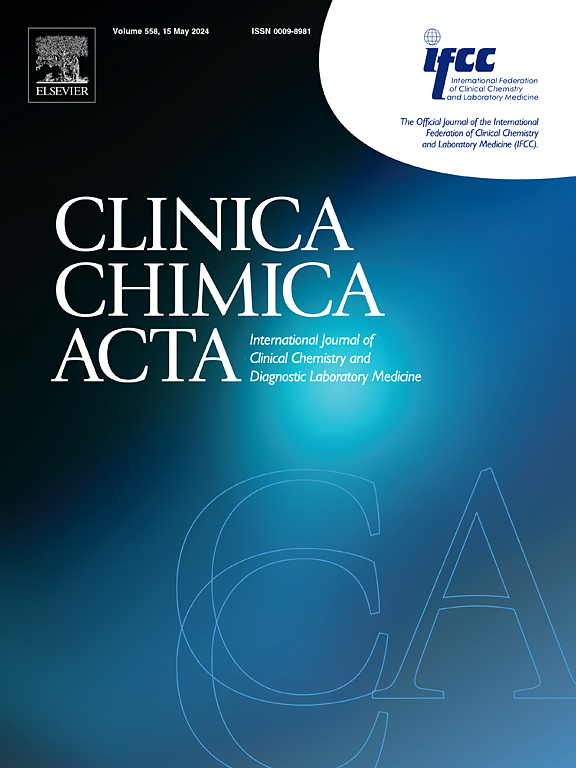A systematic review of total IgE reference intervals − A 2024 update
IF 2.9
3区 医学
Q2 MEDICAL LABORATORY TECHNOLOGY
引用次数: 0
Abstract
Background
Total IgE (tIgE) is a frequently requested analyte in patients presenting with symptoms of atopy. Although tIgE has limited clinical utility in the diagnosis of atopic diseases, it is still important that appropriate reference intervals are provided to the intepreting clinician. Concerns have recently been raised whether laboratories may be using outdated tIgE reference intervals. The aim of this study was therefore to perform the first systematic literature review of tIgE reference intervals to aid laboratories in choosing appropriate sources.
Methods
A search was performed in MEDLINE, Embase and the Cochrane Library from time of inception to July 2024. Eligible studies had to provide an estimate of paediatric and/or adult tIgE reference intervals using current generation immunoassays. The methodology followed PRISMA guidelines, and the study protocol was registered in the PROSPERO database (CRD42023396441).
Results
A total of 1667 records were screened of which 20 studies remained after full text review. The studies included 23 910 individuals and covered 18 countries. Upper reference limits varied significantly, with participant selection (inclusion or exclusion of in vitro confirmed specific IgE sensitised individuals) and statistical methods identified as the most important factors influencing the upper reference limit.
Conclusion
This review emphasises the need for laboratories to carefully evaluate the participant selection criteria and employed statistical methods whilst determining which tIgE reference intervals are the most appropriate to report to clinicians. Further efforts must also be made to harmonise and improve the reporting of tIgE reference interval studies.
总 IgE 参考区间系统回顾 - 2024 年更新。
背景:总 IgE(tIgE)是出现特应性症状的患者经常需要检测的一种分析物。尽管 tIgE 在诊断特应性疾病方面的临床作用有限,但向提供诊断的临床医生提供适当的参考区间仍然非常重要。最近有人担心实验室是否在使用过时的 tIgE 参考区间。因此,本研究旨在对 tIgE 参考区间进行首次系统性文献回顾,以帮助实验室选择合适的 tIgE 参考区间来源:方法:在 MEDLINE、Embase 和 Cochrane 图书馆中进行检索,检索时间从开始到 2024 年 7 月。符合条件的研究必须使用当前一代的免疫测定方法提供儿科和/或成人 tIgE 参考区间的估计值。研究方法遵循 PRISMA 指南,研究方案已在 PROSPERO 数据库(CRD42023396441)中注册:结果:共筛选出 1667 条记录,其中 20 项研究经过全文审阅后保留下来。这些研究涉及 23 910 人,覆盖 18 个国家。参考上限差异很大,参与者的选择(纳入或排除体外确认的特异性 IgE 致敏个体)和统计方法被认为是影响参考上限的最重要因素:本综述强调,实验室在确定哪些 tIgE 参考区间最适合向临床医生报告时,需要仔细评估参与者的选择标准和采用的统计方法。还应进一步努力协调和改进 tIgE 参考区间研究的报告工作。
本文章由计算机程序翻译,如有差异,请以英文原文为准。
求助全文
约1分钟内获得全文
求助全文
来源期刊

Clinica Chimica Acta
医学-医学实验技术
CiteScore
10.10
自引率
2.00%
发文量
1268
审稿时长
23 days
期刊介绍:
The Official Journal of the International Federation of Clinical Chemistry and Laboratory Medicine (IFCC)
Clinica Chimica Acta is a high-quality journal which publishes original Research Communications in the field of clinical chemistry and laboratory medicine, defined as the diagnostic application of chemistry, biochemistry, immunochemistry, biochemical aspects of hematology, toxicology, and molecular biology to the study of human disease in body fluids and cells.
The objective of the journal is to publish novel information leading to a better understanding of biological mechanisms of human diseases, their prevention, diagnosis, and patient management. Reports of an applied clinical character are also welcome. Papers concerned with normal metabolic processes or with constituents of normal cells or body fluids, such as reports of experimental or clinical studies in animals, are only considered when they are clearly and directly relevant to human disease. Evaluation of commercial products have a low priority for publication, unless they are novel or represent a technological breakthrough. Studies dealing with effects of drugs and natural products and studies dealing with the redox status in various diseases are not within the journal''s scope. Development and evaluation of novel analytical methodologies where applicable to diagnostic clinical chemistry and laboratory medicine, including point-of-care testing, and topics on laboratory management and informatics will also be considered. Studies focused on emerging diagnostic technologies and (big) data analysis procedures including digitalization, mobile Health, and artificial Intelligence applied to Laboratory Medicine are also of interest.
 求助内容:
求助内容: 应助结果提醒方式:
应助结果提醒方式:


